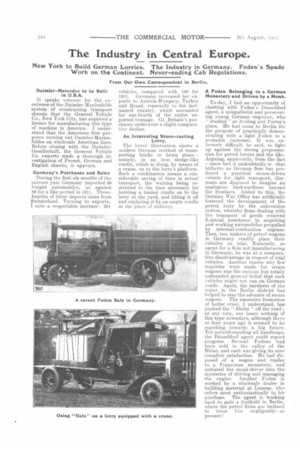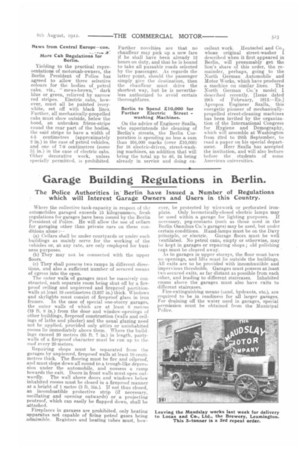The Industry in Central Europe.
Page 18

Page 19

If you've noticed an error in this article please click here to report it so we can fix it.
New York to Build German Lorries. The Industry in Germany. Foden's Spade Work on the Continent. Never-ending Cab Regulations.
From Our Own Correspondent in Berlin.
Daimler-Mercedes to be Built in U.S.A.
It speaks volumes for the excellence of the Daimler-Marienfelde system of constructing transport chassis that the General Vehicle Co., New York City, has acquired a licence for manufacturing this type of machine in America. I understand that the American firm purposes turning out Daimler-Marienfeldes on wholesale American lines. Before closing with the DaimlerGesellschaft, the General Vehicle Co. experts made a thorough investigation of French, German and English chassis, it appears.
Germany's Purchases and Sales During the first six months of the current year Germany imported 99 freight automobiles, as against 89 for a like period in 1911. Threefourths of these imports camefrom Switzerland. Turning to exports, I note a respectable increase : 291 vehicles, compared with 150 for 1911. Germany increased her exports to Austria-Hungary, Turkey and Brazil, especially to the lastnamed country, which accounted for one-fourth of the entire exported tonnage. Gt. Britain's purchases underwent a slight comparative decline.
An Interesting Stone-carting Lorry.
The lower illustration shows a modern German method of transporting bricks or hewn stone— namely, in an iron sledge-like cradle, which is slung, by means of a crane, on to the lorry's platform. Such a combination means a considerable saving of time in actual transport, the waiting being restricted to the time necessary for hoisting a loaded cradle on to the lorry at the yard, and lifting it off and replacing it by an empty cradle at the place of delivery.
A Foden Belonging to a German. Monastery and Driven by a Monk.
To-day, I had an opportunity of chatting with Foden's Dusseldorf agent, a sympathetic and persevering young German engineer, who " studied " at Aveling and Porter's place. He had come to Berlin for the purpose of practically demonstrating with a light Foden to a probable customer. It was extremely difficult, he said, to fight up against the strong prepossession for petrol lorries and the like. Arguing, apparently, from the fact —since fact it undoubtedly is—that hitherto no German firm has produced a practical steam-driven vehicle for light transport, Germans are disposed to imagine an analogous backwardness beyond the frontiers. Added to this, the German War Office has artificially fostered the development of the petrol lorry by the subvention system, whereby firms dealing with the transport of goods received fiaancial assistance in acquiring and working automobiles propelled by internal-combustion engines. Then, too, makers of petrol wagons in Germany readily place their vehicles on trial. Naturally, as agent for a firm not manufacturing in Germany, he was at a comparative disadvantage in respect of trial vehicles. Another reason why few inquiries were made for steam wagons was the curious but totally unfounded general belief that such vehicles might not run on German roads. Again, the hardness of the water in the Berlin district has helped to stay the advance of steam wagons. The excessive formation of boiler crust, I understand, has pushed the " Stoltz " off the road ; at any rate, one hears nothing of this type nowadays, although three or four years ago it seemed to be marching towards a big future. Yet notwithstanding all handicaps, the Dusseldorf agent could report progress. Several Fodens had been sold in the valley of the Rhine, and each was giving its user complete satisfaction. He had disposed of a wagon and trailer to a Franciscan monastery, and initiated the monk-driver into the mysteries of driving and managing the engine. Another Foden is worked by a wholesale dealer in building material at Lennep, who refers most enthusiastically to his purchase. The agent is workinghard to gain a foothold in Berlin. where the petrol firms are inclined to treat him negligently—at present ! More Cab Regulations for Berlin.
Yielding to the practical representationa of motorcab-owners, the Berlin President of Police has agreed to allow three selective colours for the bodies of petrol cabs, viz., "mews-brown," dark blue or green, relieved by narrow red stripes. Electric cabs, however, must all be painted ivorywhite, set off with black lines. Further, all mechanically-propelled cabs must show outside, below the hood, an unbroken frieze-stripe round the rear part of the bodies, the said stripe to have a width of 4-5 centimetres (approximately 2 in.) in the case of petrol vehicles, and one of 7-9 centimetres (some 31 in.) in the case of electric cabs. Other decorative work, unless specially permitted, is prohibited. Further novelties are that no chauffeur may pick up a new fare if he shall have been already 12 hours on duty, and that he is bound to take all passable roads selected by the passenger. As regards the latter point, should the passenger simply give the destination, then the chauffeur must drive the shortest way, but he is nevertheless authorized to avoid certain thoroughfares.
Berlin to Spend £10,000 for Further Electric Street washing Machines.
On the advice of Engineer Szalla, who superintends the cleaning of Berlin's streets, the Berlin Corporation is spending no less a sum than 204,000 marks (over 210,000) for 16 electric-driven, street-washing machines, an addition that will bring the total up to 40, 24 being already in service and doing ex cellent work. Hentschel and Co., whose original street-washer I described when it first appeared in Berlin, will presumably get the lion's share of this order, the remainder, perhaps, going: to the North German Automobile and Motor Works, which have produced a machine on similar lines. The North German Co.'s model I described recently. [Issue dated 29th of February, 1912.—ED.] Apropos Engineer Szalla, this energetic pioneer of mechanicallypropelled street-cleaning machines has been invited by the organization of the International Congress for Hygiene and Demography, which will assemble at Washington from 23rd to 28th September, to read a paper on his special department.. Herr Szalla has accepted the invitation, and will also lecture before the students of some American universities.






















